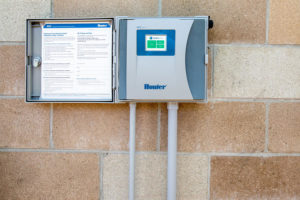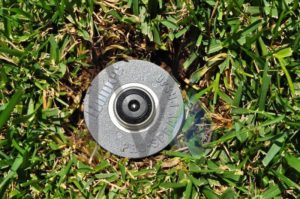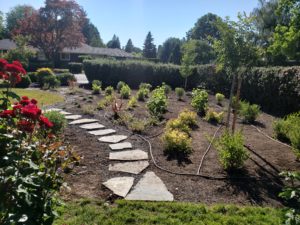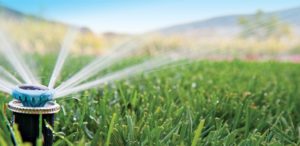Overwatering, under watering, or watering your sidewalk? Maybe it’s time for a more efficient irrigation system.

How well did your irrigation system work for your yard last spring and summer? Different areas of your yard likely need different amounts of water and even this can fluctuate throughout spring, summer and fall, and we all know your sidewalks and driveway don’t need any water all. When every drop counts, why spend another season running money down the drain?
If your irrigation system isn’t as well suited for your yard as it could be, it may be time for a new system, or at the very least, a few system fixes to optimize your watering. With an optimized irrigation system, you can be sure you’re providing the most efficient and cost-effective watering system possible.
Experienced landscapers, like us, take soil-type, topography, and specific plant needs into consideration when designing or updating an irrigation system. Delivering the right amount of water directly to plants means less water is lost to evaporation, soil is not oversaturated, and you save money. With an optimized system, you can expect to see 40% operation savings over the lifetime of your irrigation system. Consumers who invest in the right system up-front achieve significant savings in the long run. In addition to saving you money, efficient irrigation systems are significantly more environmentally-friendly. There’s really no downside!
Read our tips below to learn more about optimizing your irrigation system for better water-efficiency:
Tip #1: Work with a Certified Irrigation Auditor
Landscape East & West irrigation technicians are Irrigation Auditors, which means they have earned certification through the Irrigation Association which is an industry membership organization focused on promoting efficient and sustainable irrigation. For the consumer, Irrigation Association Certification indicates that your irrigation expert is informed of the current methods to keep landscapes verdant without wasting water.
Our Irrigation Auditors consider a range of factors when designing and setting up irrigation systems:
- The relationship between the water and soil and how soil composition impacts absorption rates.
- Incorporating a timer so watering your plants is one less thing for you to think about.
- Geographic factors that may impact water delivery (e.g. if you live on a sloped lot, our Irrigation Auditor understands how to design a system that will deliver enough water to all plants efficiently).
Tip #2: Invest in a SMART Controller
A SMART Controller is a sophisticated irrigation device that automatically adjusts water levels and times according to environmental conditions. Think of it as the brain of your irrigation system. Older systems are “brainless” in that they turn on at the same time and deliver the same amount of water each day no matter the weather or conditions. In contrast, SMART Irrigation Controllers compile information about rainfall and other weather conditions and adjust water output accordingly.
For example, a controller like the Hunter Hydrawise SMART Wi-Fi Control automatically adjusts watering based on highly accurate, internet-sourced local weather data. The system utilizes advanced Predictive Watering™, taking into consideration the forecast and past history to fine-tune watering accordingly and ensure just the right amount of water is delivered.
Installing a SMART irrigation controller is a major step forward in irrigation system optimization and can lead to significant water savings from your sprinkler system. Overall, SMART Irrigation Controllers typically reduce outdoor water use by an average of 15%-30% and a controller like the Hydrawise can save up to 50%. Not only that, many of the local water bureaus offer rebates for installing qualified SMART controllers.
Tip #3: Consider Water Pressure
It’s important to consider water pressure when making irrigation calculations and setting the timer on your system. The water pressure from city lines will vary depending on where your property is situated and will impact your irrigation system. For instance, if you live on top of a hill, the water pressure may be very high to push water to your elevation. As a result, the water coming out of your sprinklers would be highly pressurized.
setting the timer on your system. The water pressure from city lines will vary depending on where your property is situated and will impact your irrigation system. For instance, if you live on top of a hill, the water pressure may be very high to push water to your elevation. As a result, the water coming out of your sprinklers would be highly pressurized.
While higher water pressure can be a good thing in many other settings, for landscaping irrigation, it’s best to have a PSI of about 30. When irrigation water pressure is higher than 30 PSI, the water is ejected too quickly, which results in smaller droplets. This is not ideal because small drops of water evaporate more rapidly and are more likely to be blown away by wind. Larger water droplets are less likely to go to waste.
Landscape East & West Irrigation Auditors use pressure-compensating heads and regulating valves to control water pressure. Dialing down the pressure to the ideal PSI means wasting less water and saving money on your water bill.
Tip #4: Install Drip Irrigation Systems
Subtle yet effective, drip irrigation systems are less flashy than systems with spray heads, but they tend to be more productive. Rather than spraying water far and wide, drip systems deliver water directly to plant bases. The drip lines are located above the soil level, but below mulch material, such as bark chips or compost. As water flows through drip lines, it permeates down to plant roots, and because the lines are covered, evaporation-driven water waste is minimized.
Drip irrigation systems are also extremely versatile. They can be used to deliver an even watering over a specific area or drip lines can be configured to deliver varying amounts of water to different areas. For instance, a correctly-designed tree drip line would have different settings than irrigation for a flowerbed. Tree roots extend deeper into the soil, so they require irrigation that reaches deeper into the soil.
A simple way to see visual confirmation that your system is working is to install drip line indicators that rise when the irrigation system is pressurized. These indicators are micro-spray heads that don’t actually spray water; rather they elevate to let you monitor system function. This is something we can help you with at Landscape East & West.
Tip #5: Adjust Watering According to Plant Needs
Not all plants require an identical amount of water. When individual plants in shared beds have unique watering needs, the solution is a more customized system optimized to the specific needs of each plant. Our Irrigation Auditors can set up a system where each plant receives its own water line. This is the type of attention to detail that truly optimizes your irrigation system and improves your landscaping.
Tip #6: Select the Right Nozzle
Nozzle choice may seem like a minor detail, but it’s actually quite a significant element in your irrigation system’s efficiency. For example, in Portland, we tend to have soil with high clay content. Such soil acts like a sponge that soaks up water quickly. When the soil is fully saturated and no more water can be absorbed, distributing more water is a waste as it will just flow away. Because spray nozzles put out large amounts of water very quickly they’re not recommended for the clay-heavy soils we tend to have locally. For clay-ridden soils and sloped landscaping, we recommend multi-spray rotating nozzles, which mitigate water distribution for improved soil absorption.
Tip #7: Keep up with System Maintenance
No doubt, water is the most expensive part of an irrigation system. For this reason, we strongly recommend you ensure your irrigation system is wasting as little water as possible. It’ll be better for your wallet and better for the planet. With a Landscape East & West Irrigation Auditor, you’ll understand which nozzles, lines, and configurations will best suit your yard, resulting in significant long-term savings on water bills. Keeping systems properly maintained will also guarantee ongoing efficiency since any break in your irrigation line will inevitably wastewater.
Landscape East & West offers a five-year warranty on all irrigation systems we install. We also offer Premium Water Management Services for homeowners with existing systems who simply want to avoid the hassle and worry of maintenance issues. Our PWMS program covers all of your routine irrigation needs, starting with a spring start-up!
Contact us today to learn more about our expert installation, equipment repair services or our Premium Water Management Services for a healthier, water-wise yard all season long.
